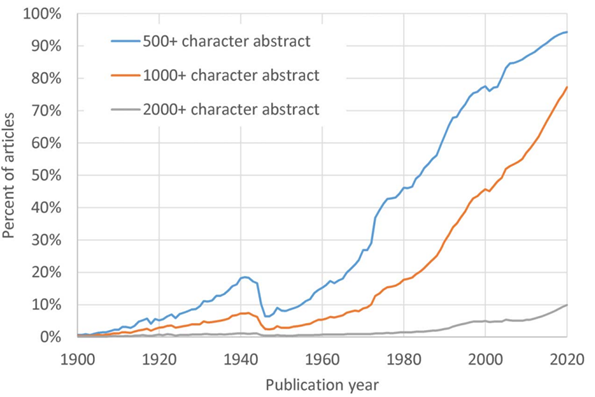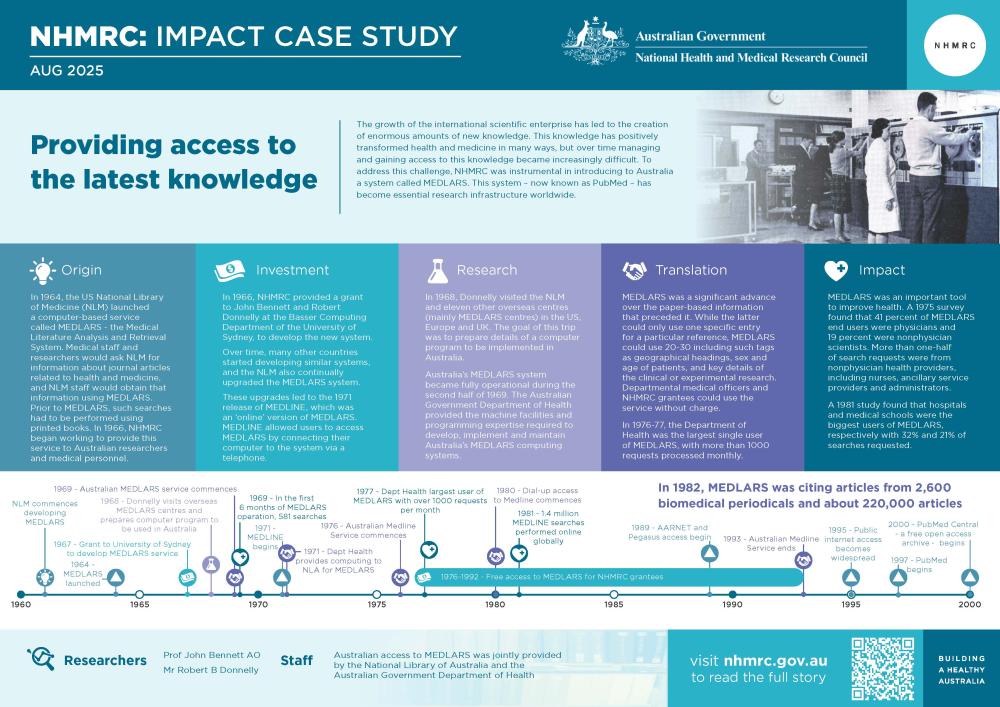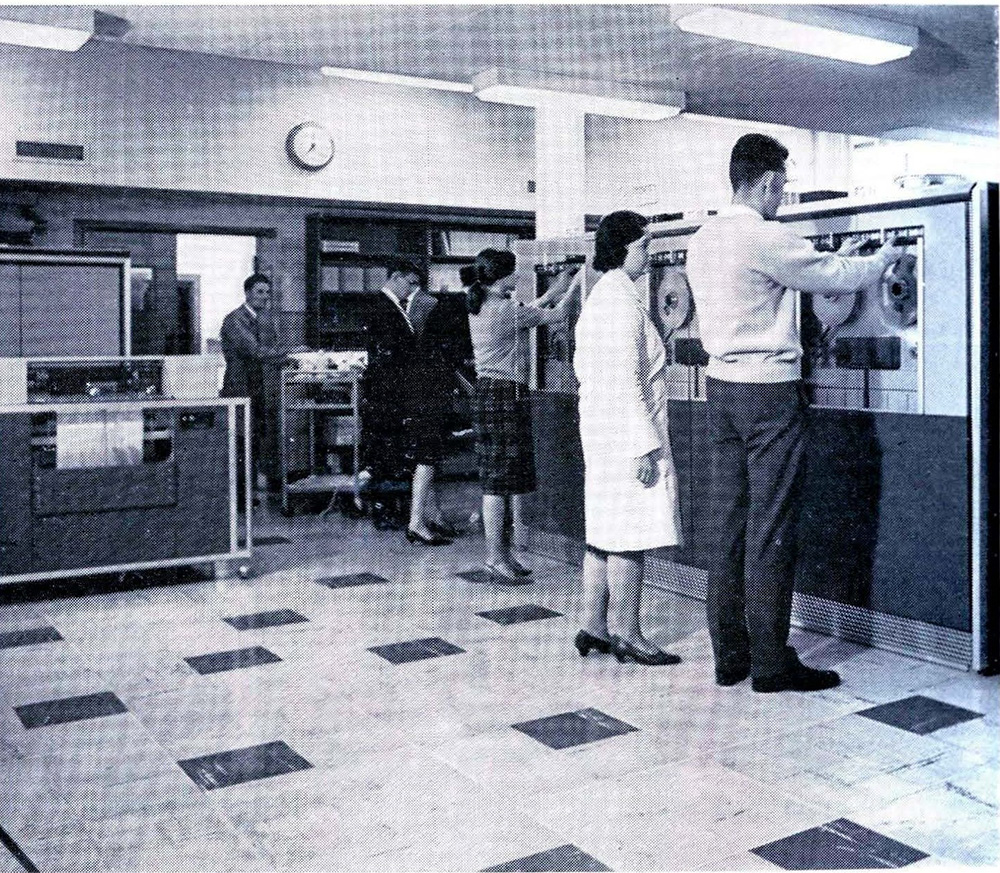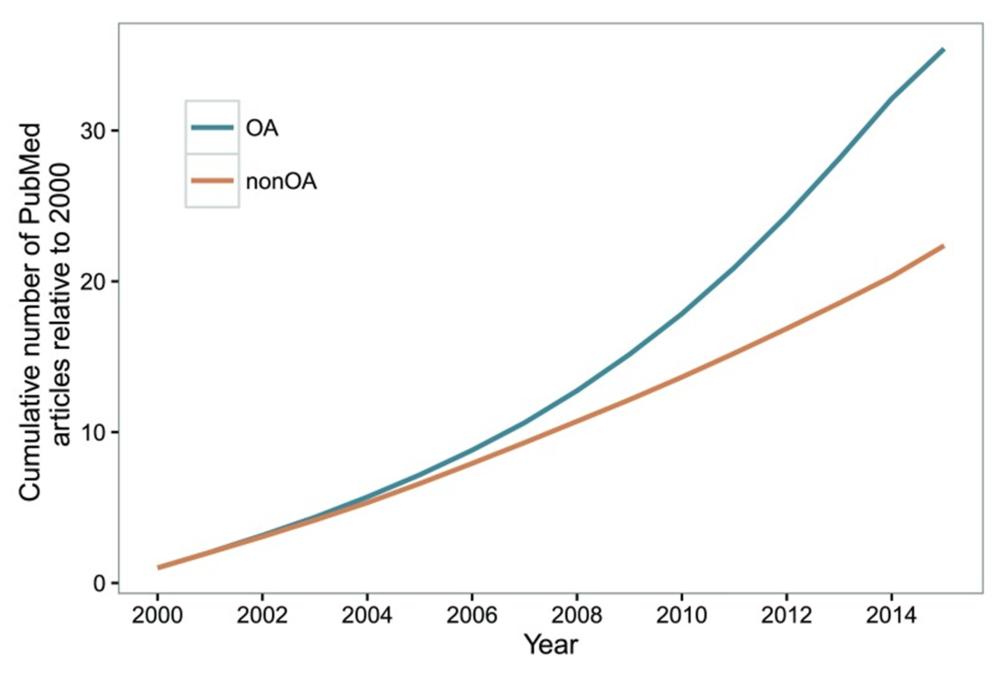The growth of the international scientific enterprise has led to the creation of enormous amounts of new health and medical knowledge that has positively transformed health care. However, during the mid-1900s, managing and gaining access to this knowledge was becoming increasingly difficult for both researchers and clinicians. To address this challenge, NHMRC was instrumental in introducing to Australia a system called MEDLARS. This system – now known as MEDLINE/PubMed – has become essential for biomedical and health researchers and clinicians worldwide.
Origin
In 1925, when future Australian Nobel Laureate John Eccles began his research, the world’s production of neuroscience literature was ‘unbelievably small, so that one could easily survey the total publications’.1 However, following the Second World War there was a massive expansion in the number of academic journals and journal articles. This expansion was highly positive for health and medicine, however it also brought challenges.

As the number of journals started to grow, researchers found it increasingly difficult to find relevant information. One method devised to assist researchers was journal abstracts: short summaries of the main goals, methods and outcomes of the research described in a journal article.

Abstracts were sometimes collected and published together within a dedicated journal such as Biological Abstracts, to speed up the process of finding relevant information. Alternatively, some journals included sections dedicated to summarising the abstracts found in other journals.
In 1879, the Library of the US Army’s Surgeon General – the predecessor of the US National Library of Medicine (NLM) – began publishing Index Medicus, a comprehensive, print bibliographic index of medical articles that was accessible to researchers if their research or medical library purchased a copy.
Index Medicus evolved over time such that, by 1964, a computerised version called the Medical Literature Analysis and Retrieval System (MEDLARS) became available. Users of MEDLARS would telephone, mail their requests, or make personal visits to the NLM and other selected sites, and trained search analysts would access the system for the desired information.
The NLM also began the distribution of Index Medicus through the production of computer data tapes. These tapes were distributed to libraries and organisations around the world which then provided localised computer access to the information. Consequently, the possibility now existed for Australia-based researchers to gain electronic access to the information contained in Index Medicus via MEDLARS. However, transforming this possibility into a reality would take significant efforts.3
Investment
The Federal Health Council (NHMRC’s precursor) was established in 1926, following the recommendations of a 1925 Royal Commission on Health. This Royal Commission made a connection between the proposed new Health Research Council and libraries, as shown in Box 1.
Box 1 – 1925 Royal Commission on Health – excerpt – Need for libraries
8. In connexion with research work, several witnesses drew attention to the need in Australia of better library facilities. Existing libraries are incomplete, and the distances between them make it difficult for investigators to consult literature that is wanting in places where they are working, but may be available in some distant library. Various suggestions were made, including the establishment of a comprehensive library at Canberra. In our opinion this proposal would involve a very large and continuous expenditure, and would not meet the requirements of workers in distant parts of the Commonwealth.
9. One of the functions of the Research Council should be to provide some means whereby research workers could study the literature of the subjects they propose to investigate. The Council might appoint an official, who, among other duties, should compile an index of available literature, giving information as to where it can be consulted, and, with the approval of the Council, employ local agents to make excerpts and digests where necessary. The Council might also make grants to libraries.
As the main other activity that the Royal Commission proposed for the Health Research Council was administering a research fund, improving access to information was considered a high priority. However, the international ‘state of the art’ for providing access to summary information about medical journal articles did not improve significantly until the development of MEDLARS in 1963. MEDLARS was first discussed by Council at its 63rd Session in 1966. The report of this session noted:
Medical Literature Analysis and Retrieval System (MEDLARS)
Council considered that in view of the difficulties faced by research workers in keeping abreast of the current literature, a medical literature retrieval system was desirable in Australia. Council recommended that an investigation be carried out into the costs involved in the retrieval aspects of the MEDLARS System developed by the National Library of Medicine in Washington.
Also in 1966, NHMRC provided a grant to John Bennett and Robert Donnelly at the Basser Computing Department of the University of Sydney, to investigate this issue further.

The PDF poster version of this case study includes a graphical timeline showing NHMRC grants provided and other events described in the case study.
Research
NHMRC’s 1967 Report to Parliament includes a report on the MEDLARS project, and the following description of the challenge (refer to Box 2):
Box 2 – MEDLARS
The United States National Library of Medicine has been following the policy of setting up a number of centres throughout the world to serve the needs of the regions in which they are situated. Every month each of these centres is supplied with magnetic tapes from Bethesda containing details of recent literature coded for MEDLARS during the month. Information provided in this way is consolidated with a master file also held on magnetic tape. From libraries throughout the region, search requests, the details of which are set out by librarians who have been given special instructions of the techniques required, are channelled to the regional centres concerned. Searches based on these requests are carried out at regular intervals, the results being returned via the originating libraries.
The process of setting up a regional centre in Australia consists of arranging for suitable computing facilities to be adapted to utilise the National Library of Medicine tapes, and training search personnel. The project is concerned with the first of these activities. As the computing machines available (an English Electric KDF 9 and an IBM 7040) are not the same type as that used at Bethesda, the first step in carrying out this adaptation is to obtain details of the programmes used at Bethesda and other regional centres, so that the scheme used here can embody the results of experience gained elsewhere.
To accumulate the knowledge necessary to establish a regional MEDLARS centre in Australia, during the period September 1967 to February 1968, Donnelly visited the NLM and eleven other overseas centres concerned with information retrieval activity (mainly MEDLARS centres in the US, Europe and UK). The primary goal of this trip was to prepare details of a computer program to be implemented in Australia.

Operators working at the magnetic tape units in the Basser Computing Department, University of Sydney. Source: NHMRC4
In March 1969, the National Library of Australia (NLA) entered into a formal agreement with the NLM to establish the NLA as the Australian Centre for MEDLARS.5 A trial version of the system became operational at the University of Sydney in May 1969 and more than 150 bibliographies were produced as a result of requests originated by areas within the university.4
MEDLARS became fully operational in Australia during the second half of 1969 and after that a regular weekly processing of MEDLARS requests was carried out, with almost 600 searches requested during the remainder of the 1969 calendar year.6
Translation
Once operational, Australian access to the MEDLARS system was facilitated – ongoing – by the Australian Government Department of Health in collaboration with the NLA. The Department provided the machine facilities and programming expertise required to develop, implement and maintain the computing systems which were an integral part of the service.7 From March 1971, the Department was providing full MEDLARS computing facilities to the NLA.8
MEDLARS was a significant advance over Index Medicus. While the latter could only use one specific entry for a particular reference, MEDLARS could use 20–30 ‘including such tags as geographical headings, sex and age of patients, types of animals used in experiments, clinical or experimental research, etc’.9
By 1972, the NLM had 8 international MEDLARS arrangements: with Australia, the United Kingdom, Sweden, France, West Germany, Japan, Canada and the World Health Organization.10 By 1978, international arrangements also included Iran, Italy, Mexico, South Africa.11 The service available in Australia was comparatively advanced: for example, the first searches processed for customers of the UK’s MEDLARS Service did not take place until 1976, 7 years after the service was available in Australia.12
In 1972, a new Current Awareness Service commenced in Australia, provided by the NLA. Once an initial search had been completed for a MEDLARS user, that user could indicate that they would like a regular output of references for this search. The researcher’s specific topic areas were then matched monthly against the updated MEDLARS database and any citations received were sent to the researcher by mail. This was a great advance, as researchers using the service could now receive citation information several months ahead of those who did not.10
In 1971, the NLM had made available a new service – MEDLINE – which allowed users direct access to the MEDLARS database via dedicated computer terminals. This service became available in Australian in 1976 and was ‘considered one of the most exciting developments in medical librarianship over the previous decade’.13
Commencing in 1977, NHMRC grantees received additional benefits from the system. As recorded in NHMRC’s Council Session records for 1977: 14
Provision of MEDLARS/MEDLINE searches free of charge to NHMRC grantees
The Council noted that, in association with the National Library and the Commonwealth Department of Health, it was instrumental in the introduction of MEDLARS to Australia. It was important therefore that the Council's grantees be able to avail themselves of these services under the most favourable conditions possible. A decision had been taken by the National Library and the Department of Health that various categories such as departmental medical officers, NHMRC Committees and NHMRC grantees should be provided with MEDLARS/MEDLINE services without charge.
That said, in 1976–77, the Department of Health was the largest single user of MEDLARS, with more than 1,000 requests processed monthly.15 Shortly after MEDLINE’s introduction in Australia, users of all types were able to obtain access to the system by dialling a local telephone number.16
While the MEDLARS/MEDLINE service continued to operate throughout the 1980s, by the end of that decade, broader technological changes began to make the system obsolete. In 1989, the internet became available to universities via the Australian Academic and Research Network (AARNeT) and to the public via the Pegasus Networks and then by a range of dial-up Internet Service Providers.
As a consequence, in June 1993 the Australian Medline Network ceased to operate. In 1997, the NLM facilitated widespread internet-based access to the system with its launch of PubMed, which also started to provide access to full text versions of journal articles (that is, open access).17

Outcomes and Impacts
By the time that free access to MEDLARS was available to NHMRC-funded researchers, the system was already an important tool to improve health. A survey conducted by NLM in 1975 found that 41 percent of MEDLARS end users were physicians, 19 percent were nonphysician scientists, 30 percent were students and other types of users, while 10 percent were librarians. A different survey, reported on in 1982, found that more than one-half of search requests were from nonphysician health providers, including nurses, ancillary service providers, and administrators.18
Searches were requested for a variety of purposes, including to aid in providing patient care, preparing presentations and journal articles, planning new services and purchasing equipment. A 1981 study found that hospitals and medical schools were the biggest users of MEDLARS, respectively with 32% and 21% of searches requested.18
More recently, MEDLINE has been shown to be a critical clinical care tool that health care professionals use to protect patient health, make changes to patient care, and to answer clinical questions. A 2017 study found that the two resources most frequently used by US-based health care professionals were journals (print and online) and MEDLINE.19 This was despite the development of other literature-based resources and ‘point-of-care’ tools (that is, resources that healthcare professionals use at the patient's bedside or during a consultation to quickly access and apply evidence-based information).
When MEDLARS was first developed there was no direct interaction between the searchers and the computer, the process was expensive, and the time between the submission of a request and receipt of the resulting bibliography ranged from 3 to 6 weeks.20 But with the development of the internet it was possible for every individual user of MEDLINE to submit their own unique search request and to receive results back almost instantly. MEDLINE/PubMed is now the premier biomedical literature database in the world and it continues to be one of the most widely accessible resources for scientists and health care providers globally.20
Once MEDLINE was established, the system was in a constant state of expansion. In 1972, 4,131 searches were performed using the system but by 1981 this was 1.435 million.20
In 1982, MEDLARS was citing articles from 2,600 biomedical periodicals published in 36 languages and about 220,000 articles were being added annually.20 By 2023, PubMed/MEDLINE was indexing about 1.3 million new articles annually, and from over 5,200 medicine and bioscience journals. Worldwide, the system was supporting over 3.6 billion searches annually.21 In 2022, PubMed provided access to over 3 million full text manuscripts.22
Researchers
Professor John Bennett AO
John Makepeace Bennett (1921–2010) studied civil engineering at the University of Queensland. From 1942 until 1946 he served in the Royal Australian Air Force, then returned to the University of Queensland to study electrical and mechanical engineering and mathematics.
In 1947, Bennett worked at Cambridge University as part of the team building the Electronic Delay Storage Automatic Calculator (EDSAC), the world's first practical stored program electronic computer and, from 1949, the world's first computer in regular operation. He used EDSAC to carry out the first ever structural engineering calculations on a computer as part of his PhD.
Bennett then worked for the UK-based electrical engineering and equipment firm Ferranti (now Ferranti Computer Systems) as a computer specialist. Here he designed the instruction set for Ferranti Mark 1*, which was the main improvement of that machine over Ferranti Mark 1, which was the world's first commercially available general-purpose electronic computer.
In 1956, Bennett returned to Australia to become numerical analyst (and later senior numerical analyst) to the Adolph Basser Laboratory at the University of Sydney. In 1972, Bennett was appointed head of a new Basser Department of Computer Science, and from 1982-1987 he was Professor of Computer Science. Bennett was the first professor of computer science in Australia and Foundation President of the Australian Computer Society (1966–1967).
In 1983, Bennett was appointed an Officer of the Order of Australia for service to computing science. In 2001, he was awarded the Centenary Medal for service to Australian society in computer science and technology. In 2004, Bennett was awarded the Pearcey Medal, an annual award presented to a distinguished Australian for a lifetime and outstanding contribution to the ICT industry.
Mr Robert Donnelly
Robert (Bob) B Donnelly was computing laboratory manager within the University of Sydney’s School of Physics, and in 1972 was appointed manager of the Basser Computing Centre.
Partner
This case study was developed with input from NHMRC’s Research Committee and in partnership with the National Library of Australia.

References
The information and images from which impact case studies are produced may be obtained from a number of sources, including NHMRC’s internal records and publicly available materials. Key sources of information consulted for this case study include:
1 Eccles JC. My scientific odyssey. Annu Rev Physiol. 1977;39:1-18
2 Thelwall M, Sud P. Scopus 1900–2020: Growth in articles, abstracts, countries, fields, and journals. Quantitative Science Studies. 2022 Apr 12;3(1):37-50.
3 National Library of Medicine. MEDLINE History. Source: https://www.nlm.nih.gov/medline/medline_history.html. Accessed: 17 July 2025
4 National Health and Medical Research Council. Thirty-second Annual Report, for 1969. Commonwealth Government Printing Office, Canberra, 1971.
5 Ian McCallum. We’re on a mission. Libraries for the nation. We can do this. 2016. The Australian Library Journal, 65:2, 107-120
6 National Health and Medical Research Council. Report for 1970. The Parliament of the Commonwealth of Australia – 1971 – Parliamentary Paper No. 122. Commonwealth Government Printing Office, Canberra, 1972
7 Annual Report by the Director-General of Health for year 1968-69. The Parliament of the Commonwealth of Australia – 1969 – Parliamentary Paper No. 170. Commonwealth Government Printing Office, Canberra, 1969
8 Director-General of Health Annual Report for year 1970-71. The Parliament of the Commonwealth of Australia – 1971 – Parliamentary Paper No. 191. Commonwealth Government Printing Office, Canberra, 1972
9 Medical Librarians Group – Victorian Branch, Newsletter December 1972; https://read.alia.org.au/newsletter-december-1972
10 Corning ME. The US National Library of Medicine and international MEDLARS cooperation. Information Storage and Retrieval. 1972 Dec 1;8(6):255-64.
11 Dee CR. The development of the Medical Literature Analysis and Retrieval System (MEDLARS). J Med Libr Assoc. 2007 Oct;95(4):416-25
12 Barley AJ, (1977) The UK MEDLARS service: a personal view of its first decade, Aslib Proceedings, Vol. 29 No. 9, pp. 320-325
13 Orbell-Smith J, Giltrap H (eds). Health Libraries Australia. HLA News ISSN 1448-0840 Spring 2016. Source https://read.alia.org.au Accessed 17 July 2025
14 Commonwealth Department of Health. National Health and Medical Research Council. Report of the 83rd Session. Hobart, April 1977. Australian Government Publishing Service, Canberra, 1977
15 Director-General of Health Annual Report 1976-77. The Parliament of the Commonwealth of Australia - Parliamentary Paper No. 289/1977. Commonwealth Government Printer, Canberra, 1978
16 Department of Health Annual report 1978-79. The Parliament of the Commonwealth of Australia. Parliamentary Paper No. 319/1979.
17 Tennant JP, Waldner F, Jacques DC, Masuzzo P, Collister LB, Hartgerink CH. The academic, economic and societal impacts of Open Access: an evidence-based review. F1000Res. 2016 Apr 11;5:632
18Office of Technology Assessment. MEDLARS and Health Information Policy – A Technical Memorandum. September 1982. Library of Congress Catalog Card Number 82-600639. NTIS order #PB83-168658
19 Dunn K, Marshall JG, Wells AL, Backus JEB. Examining the role of MEDLINE as a patient care information resource: an analysis of data from the Value of Libraries study. J Med Libr Assoc. 2017 Oct;105(4):336-346
20 Ossom Williamson P, Minter CIJ. Exploring PubMed as a reliable resource for scholarly communications services. J Med Libr Assoc. 2019 Jan;107(1):16-29
21 National Library of Medicine. MEDLINE PubMed Production Statistics – FY2023-FY2018. Source: https://www.nlm.nih.gov/bsd/medline_pubmed_production_stats.html Accessed: 17 July 2025
22 Kim W, Yeganova L, Comeau DC, Wilbur WJ, Lu Z. Towards a unified search: improving PubMed retrieval with full text. Journal of biomedical informatics. 2022 Oct 1;134:104211.